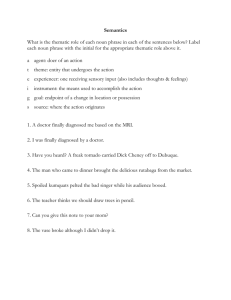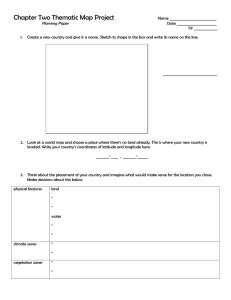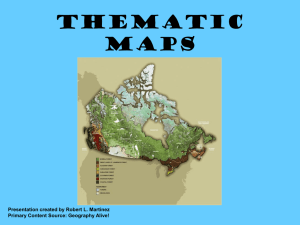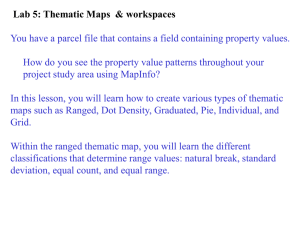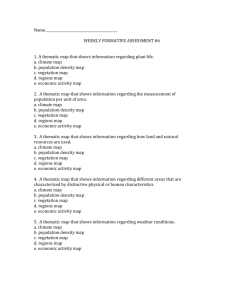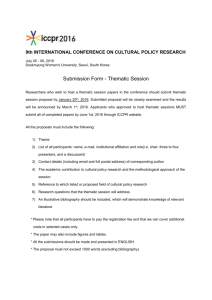Thematic Units: Integrating the Curriculum
advertisement
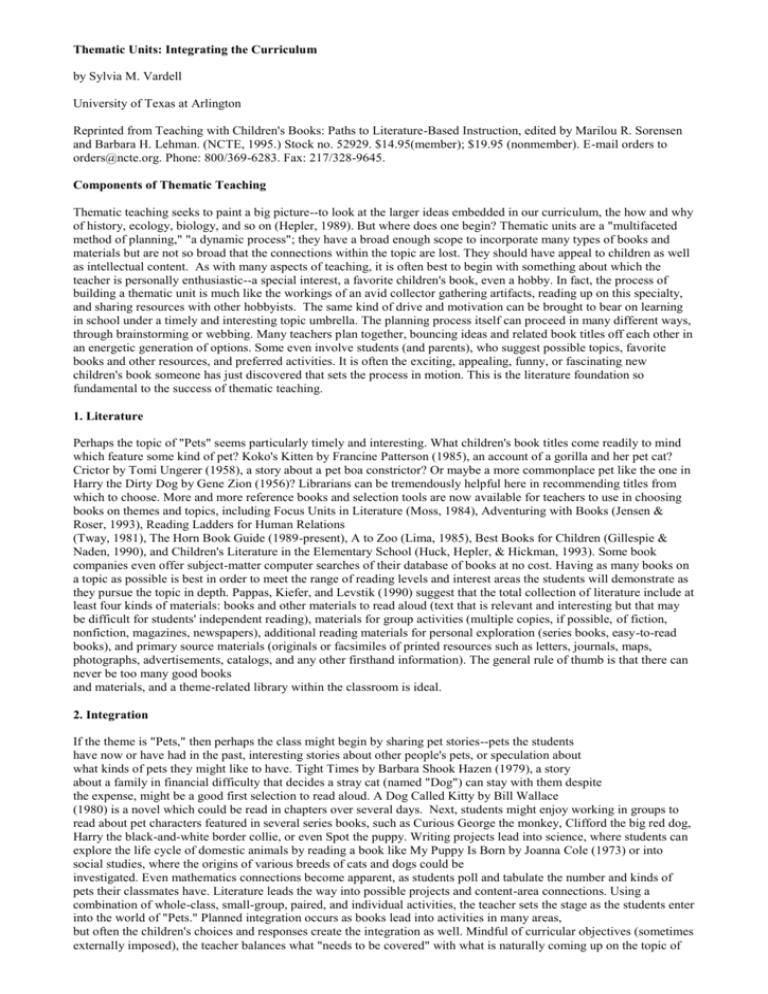
Thematic Units: Integrating the Curriculum by Sylvia M. Vardell University of Texas at Arlington Reprinted from Teaching with Children's Books: Paths to Literature-Based Instruction, edited by Marilou R. Sorensen and Barbara H. Lehman. (NCTE, 1995.) Stock no. 52929. $14.95(member); $19.95 (nonmember). E-mail orders to orders@ncte.org. Phone: 800/369-6283. Fax: 217/328-9645. Components of Thematic Teaching Thematic teaching seeks to paint a big picture--to look at the larger ideas embedded in our curriculum, the how and why of history, ecology, biology, and so on (Hepler, 1989). But where does one begin? Thematic units are a "multifaceted method of planning," "a dynamic process"; they have a broad enough scope to incorporate many types of books and materials but are not so broad that the connections within the topic are lost. They should have appeal to children as well as intellectual content. As with many aspects of teaching, it is often best to begin with something about which the teacher is personally enthusiastic--a special interest, a favorite children's book, even a hobby. In fact, the process of building a thematic unit is much like the workings of an avid collector gathering artifacts, reading up on this specialty, and sharing resources with other hobbyists. The same kind of drive and motivation can be brought to bear on learning in school under a timely and interesting topic umbrella. The planning process itself can proceed in many different ways, through brainstorming or webbing. Many teachers plan together, bouncing ideas and related book titles off each other in an energetic generation of options. Some even involve students (and parents), who suggest possible topics, favorite books and other resources, and preferred activities. It is often the exciting, appealing, funny, or fascinating new children's book someone has just discovered that sets the process in motion. This is the literature foundation so fundamental to the success of thematic teaching. 1. Literature Perhaps the topic of "Pets" seems particularly timely and interesting. What children's book titles come readily to mind which feature some kind of pet? Koko's Kitten by Francine Patterson (1985), an account of a gorilla and her pet cat? Crictor by Tomi Ungerer (1958), a story about a pet boa constrictor? Or maybe a more commonplace pet like the one in Harry the Dirty Dog by Gene Zion (1956)? Librarians can be tremendously helpful here in recommending titles from which to choose. More and more reference books and selection tools are now available for teachers to use in choosing books on themes and topics, including Focus Units in Literature (Moss, 1984), Adventuring with Books (Jensen & Roser, 1993), Reading Ladders for Human Relations (Tway, 1981), The Horn Book Guide (1989-present), A to Zoo (Lima, 1985), Best Books for Children (Gillespie & Naden, 1990), and Children's Literature in the Elementary School (Huck, Hepler, & Hickman, 1993). Some book companies even offer subject-matter computer searches of their database of books at no cost. Having as many books on a topic as possible is best in order to meet the range of reading levels and interest areas the students will demonstrate as they pursue the topic in depth. Pappas, Kiefer, and Levstik (1990) suggest that the total collection of literature include at least four kinds of materials: books and other materials to read aloud (text that is relevant and interesting but that may be difficult for students' independent reading), materials for group activities (multiple copies, if possible, of fiction, nonfiction, magazines, newspapers), additional reading materials for personal exploration (series books, easy-to-read books), and primary source materials (originals or facsimiles of printed resources such as letters, journals, maps, photographs, advertisements, catalogs, and any other firsthand information). The general rule of thumb is that there can never be too many good books and materials, and a theme-related library within the classroom is ideal. 2. Integration If the theme is "Pets," then perhaps the class might begin by sharing pet stories--pets the students have now or have had in the past, interesting stories about other people's pets, or speculation about what kinds of pets they might like to have. Tight Times by Barbara Shook Hazen (1979), a story about a family in financial difficulty that decides a stray cat (named "Dog") can stay with them despite the expense, might be a good first selection to read aloud. A Dog Called Kitty by Bill Wallace (1980) is a novel which could be read in chapters over several days. Next, students might enjoy working in groups to read about pet characters featured in several series books, such as Curious George the monkey, Clifford the big red dog, Harry the black-and-white border collie, or even Spot the puppy. Writing projects lead into science, where students can explore the life cycle of domestic animals by reading a book like My Puppy Is Born by Joanna Cole (1973) or into social studies, where the origins of various breeds of cats and dogs could be investigated. Even mathematics connections become apparent, as students poll and tabulate the number and kinds of pets their classmates have. Literature leads the way into possible projects and content-area connections. Using a combination of whole-class, small-group, paired, and individual activities, the teacher sets the stage as the students enter into the world of "Pets." Planned integration occurs as books lead into activities in many areas, but often the children's choices and responses create the integration as well. Mindful of curricular objectives (sometimes externally imposed), the teacher balances what "needs to be covered" with what is naturally coming up on the topic of Pets. Flexibility is central, as teachers reconfigure the traditional scope and sequence of the curriculum in new ways. Now the subject-area textbooks are viewed as just another tool, rather than as the sole decision maker for instruction. The outcome, however, is generally a more comprehensive curriculum, filled with extensive learning experiences, rather than the former minimal content considered necessary for basic mastery. Teachers vary greatly in how far they take the integration of their thematic units. Some teach no reading and writing in isolation. Instead, students read extensively about the topic (e.g., Pets) and write in a variety of formats that help them to better understand and explore the topic (e.g., a letter to a veterinarian, a research paper about guide dogs). The degree of integration depends somewhat on the individual style and interests of the teacher. But like a machine set in motion, integration takes on a life of its own, and everyone involved in thematic teaching looks for connections and finds them well beyond what was initially planned, making it a truly interdisciplinary approach. Without such integration, thematic teaching is simply a potpourri of lots of extra books--not bad, but not nearly enough. 3. Collaboration Thematic teaching, it should be readily apparent, is labor-intensive. It takes extra time to replace lessons based strictly on textbooks or workbooks with something new. But as Pappas, Kiefer, and Levstik (1990) point out, all good teaching takes time. Teachers who plan thematic units together find that the workload is easier and the planning becomes more dynamic and satisfying. In fact, prepackaged units now on the market lack this personal connection. Though these sets may have excellent booklists and some good ideas and activity options, many teachers feel part of the pleasure of thematic teaching is the digging and searching and the finding and gathering of resources. This also sets the stage for an aspect of thematic units that seems to occur spontaneously--people interact when they work together toward common goals and are surrounded with interesting materials and resources. Teachers do; children do. Thematic teaching is strongest in social classrooms where the teacher and students learn together by sharing and exchanging ideas with each other. All are encouraged and expected to share their backgrounds, prior knowledge, and individual interests for the common good: funny dog and cat stories from childhood, anecdotes about a parakeet or rabbit. Together, everyone researches the problem of unwanted pets and animal rights. Without such collaboration in thematic teaching, the emphasis shifts to a subtle competition, where each student works in secrecy to outdo the other with individual Pet projects, and then only for the academic prize of a good grade, rather than for the pleasure of discovering something new and interesting and telling someone about it. 4. Community Resources Theoretically one could plan and teach an entire thematic unit without using community resources, but this component is vital in making yet another connection for students--the real-world connection. Parents can play an important role in sharing their experience and expertise. Businesses, organizations, museums, and so forth can offer rich resources that extend and enrich the unit by providing practical, concrete examples and applications. For example, in a unit on Pets, parents might be requested to bring family pets for classroom visits; a eterinarian or pet shop owner might be willing to talk to the class about pet care; the Society for the Prevention of Cruelty to Animals or local Humane Society might welcome the interest of a classroom seriously studying the topic. Here, also, a connection with concrete, physical objects, artifacts, or crafts can provide students with new firsthand experiences. How do you hold a hamster? Do most dogs really prefer to be stroked behind their ears? Media, too, add another dimension of learning through audiotapes, videotapes, photography, music, art, puppetry, and so forth. Children involved in thematic units are more apt to bring more to the field trip or outing--more information, more questions, more interest. A "culture of the topic" evolves, one of collective experience and participation. Students who learn that school is not the only place to learn things will say, "Remember that time we studied Pets, and. . ." 5. Time It takes time to plan thematic units, and the units themselves generally last several weeks. Because the learning is integrated and collaborative, momentum builds and sustains motivation. Thus the topic can be explored both in its breadth and depth. During a sample study of Pets, one child's reading and research may lead into an extensive study of the rottweiler, piqued by fondness for the book Good Dog, Carl by Alexandra Day (1985), while another child might also share discoveries about Koko the gorilla and her new Manx kitten from reading Koko's Kitten by Francine Patterson (1985). Thematic teaching provides time for students to read many books because they are not reading just in "Reading" class. It also encourages a great deal of thinking because students are ctively using that reading in real situations--whenever it comes up. There is greater continuity and less pressure since the topic is ongoing. Study can be picked up tomorrow where it was left off yesterday. Thus time--perhaps the "traditional" teacher's worst enemy--now becomes an ally. Finally, the passing of time allows students to develop a portfolio of varied activities, rather than the sameness sometimes provided by textbook-based instruction. 6. Empowerment Despite the fact that empowerment has become somewhat of a buzzword, it is a real factor in thematic classrooms where teachers have consciously chosen to teach in a new way. In particular, thematic teaching challenges both overreliance on textbooks and the compartmentalized school day and its subjects. Many teachers have long questioned this practice. They know the curriculum; they know their children. Who is better suited to decide how to teach them both? As teacher Martha Davidson commented: "The teacher can more readily develop a clearcut objective for the unit, since its structure is under her control. The activities chosen can be tailored to meet the objective and the students' needs . . . the teacher has the needed latitude with which to work." Pappas, Kiefer, and Levstik (1990) contend, "Teachers in integrated classrooms see themselves as professionals who own and develop their own programs" (p. 40). These are the same teachers who abdicate some of their traditional authority in the classroom to empower their students to take a more active role in their own learning. Conclusion Visit the classroom of someone involved in thematic teaching. Often one can hear the excitement in the hall, as talk about books and projects spills out the door. One place to start may be in collaborating with a teacher friend on an end-of-the-year thematic unit. A school in Texas devoted several weeks in May to a whole-school thematic unit on the topic of the "Frontier." All classrooms were involved with books and activities integrated around the theme. Then, as a culminating event, the entire school devoted a whole day to an indoor/outdoor Frontier fair at which parents dressed in costumes, cooked on outdoor grills, read aloud, and demonstrated crafts. These are the kinds of learning activities that children (and teachers, parents, and all involved) remember for years to come. As teacher Liz Lumpkins put it, "A successful thematic unit plants the seeds for continued investigation and further inquiry in students' minds that will grow into a lifelong yearning for knowledge." References Gillespie, J., & Naden, C. (Eds.). (1990). Best books for children (4th ed.). New York: R. R. Bowker. Hepler, S. (1989). A literature program: Getting it together, keeping it going. In J. Hickman & B. Cullinan (Eds.), Children's literature in the classroom: Weaving Charlotte's web. Needham Heights, MA: Christopher-Gordon. The Horn Book Guide (1989-present; issued biannually). Boston: Horn Book. Huck, C., Hepler, S., & Hickman, J. (1993). Children's literature in the elementary school (5th ed.). San Diego: Harcourt Brace Jovanovich. Jensen, J. M., & Roser, N. L. (Eds.). (1993). Adventuring with books: A booklist for pre-K-grade 6 (NCTE Bibliography Series, 10th ed.). Urbana, IL: National Council of Teachers of English. Lima, C. (1985). A to zoo: Subject access to children's picture books. New York: R. R. Bowker. Moss, J. (1984). Focus units in literature: A handbook for elementary school teachers. Urbana, IL: National Council of Teachers of English. Pappas, C., Kiefer, B., & Levstik, L. (1990). An integrated language perspective in the elementary school. White Plains, NY: Longman. Tway, E. (Ed.). (1981). Reading ladders for human relations (6th ed.). Urbana, IL: National Council of Teachers of English. Children's Books Cited Branley, Franklyn M. (1985) Flash, crash, rumble, and roll. New York: Thomas Y. Crowell Bridwell, Norman. (1963). Clifford the big red dog. Illus. by Author. (Also see other books in the series.) New York: Scholastic. Cole, Joanna. (1973). My puppy is born. New York: William Morrow. Day, Alexandra. (1985). Good dog, Carl. Illus. by Author. New York: Simon & Schuster. Hazen, Barbara Shook. (1979). Tight times. New York: Viking. Hill, Eric. (1980). Where's Spot? Illus. by Author. (Also see other books in the series.) New York: G. P. Putnam's Sons. Lund, Doris. (1966). Attic of the wind. New York: Parents Magazine Press. Patterson, Francine. (1985). Koko's kitten. New York: Scholastic. Rey, H. A. (1942). Curious George. Illus. by Author. (Also see other books in the series.) Boston: Houghton Mifflin. Ungerer, Tomi. (1958). Crictor. Illus. by Author. New York: Harper & Row. Wallace, Bill. (1980). A dog called kitty. New York: Holiday House.

